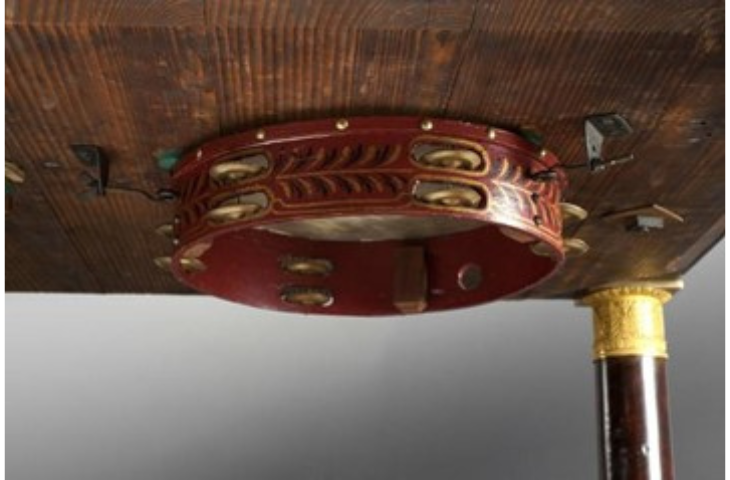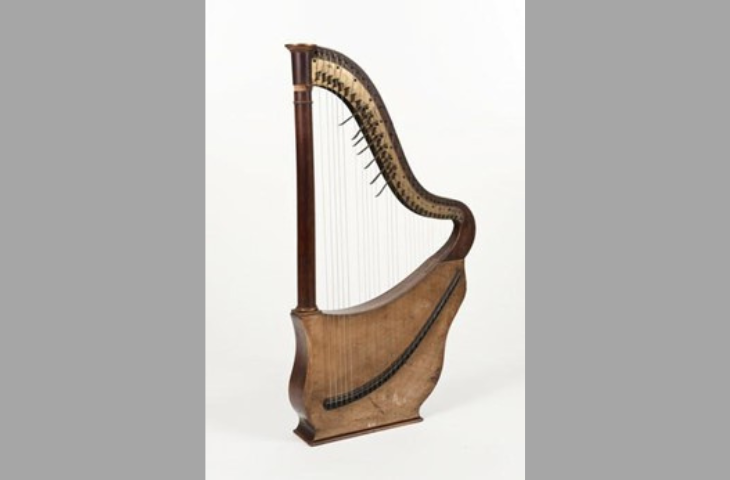December 2024
Fig.1

Square piano with Turkish pedal, Jean Pfeiffer, Paris, 1818, inv. 3320
Fig.2

Square piano with Turkish pedal (name board and keyboard), Jean Pfeiffer, Paris, 1818, inv. 3320
Fig.3

Square piano with Turkish pedal (tambourine), Jean Pfeiffer, Paris, 1818, inv. 3320
Fig.4

Harpolyre by Pfeiffer, Paris, around 1830, inv. 0248
Fig.5

Harpolyre by Pfeiffer, Paris, around 1830, inv. 0249
Luxurious piano-table by Jean Pfeiffer
This luxurious piano-table (fig.1) was made by Jean Pfeiffer (1769-1838), an important piano and harp maker active in Paris in the early 19th century. The case of the instrument is a fine example of the Empire style: veneered in burr mahogany, decorated with gilded motifs chased in bronze, it rests on four legs in the form of Doric columns. The keyboard is beautifully veneered in mother-of-pearl and ebony. The name board is made using the eglomised glass technique and bears the words: Pfeiffer/ Brevetés et Encouragés du Gouvernement/ Rue du Mail N°29, à Paris 1818 (fig.2).
In addition to its particularly refined decoration, the instrument is unusual in that it has five pedals - bassoon, lute, forte, celeste and turquerie - whereas standard instruments of the time had only two or three. The first four change the timbre of the instrument. The fifth is very special: it activates a tambourine attached to the bottom of the instrument (Fig.3). Called turquerie in reference to the percussive aspect of Turkish music, it reflects the infatuation of the period with the music of the janissaries. These elite infantry troops, dressed in sumptuous costumes and under the direct command of the Ottoman sultan, were renowned for their music. They inspired a number of works, the most famous of which is undoubtedly Mozart's Turkish March, while percussion instruments - bass drums (called Turkish drums in the 18th century), triangles and cymbals - were introduced into the Western orchestra and integrated into certain pianos by means of pedals.
Jean Pfeiffer: innovator and inventor of the harpolyre
Born in Trier, Jean Pfeiffer started out as a turner before joining the workshop of a piano maker in Sélestat. He moved to Paris in 1801 and in April 1806 founded Pfeiffer & Cie, a factory for the manufacture of pianos using a new system. He was associated with Guillaume Lebrecht-Petzold (Lichtenhayn, Saxony 1774 - Paris 1838), whose name will always be remembered for the invention of an ingenious escapement mechanism known as the Petzold mechanism. Pfeiffer was present at every Exhibition of the products of French industry. He won numerous medals. He is known as having perfected the square piano in such a way that it produces sounds as beautiful, vigorous and velvety as those of the grand piano.
Around 1830, Pfeiffer invented a small harp with a large resonance chamber at its base - called the harpolyre (fig.4 & fig.5). According to François-Joseph Fétis, Pfeiffer believed his instrument was destined to replace the guitar advantageously, because it was also portable and offered more resources and more powerful sounds. However, the harpolyre was not successful. Several harpolyres and square pianos by Pfeiffer are held in public and private collections. Their particularly meticulous craftsmanship testifies to the skill of their maker.
Text: Pascale Vandervellen